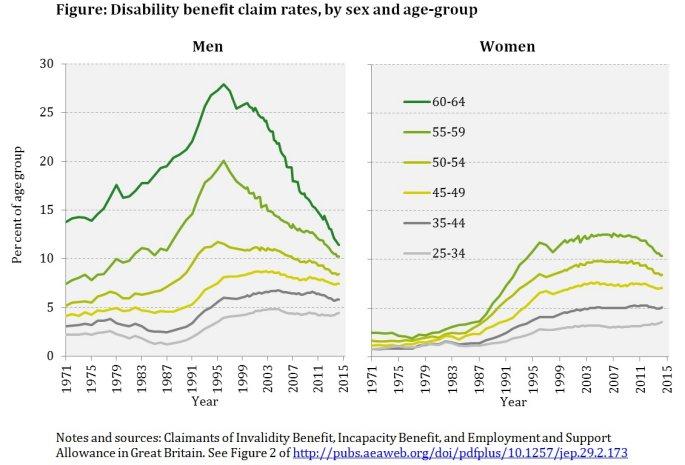Reform of disability benefits is high on the public policy agenda in many countries. In the UK there have been several major reforms in the last 20 years, perhaps most notably the replacement of Invalidity Benefit with Incapacity Benefit in 1995 and the replacement of Incapacity Benefit with Employment and Support Allowance from 2008. A key aim of reforms over this period has been to reduce public spending through making benefits harder to claim and through moving more recipients off these benefits and into paid work.
Over the same period there have been significant changes in spending on these benefits, the numbers receiving these benefits and their characteristics. Our new research paper, published in the Journal of Economic Perspectives, documents some of these trends.
The observed trends are dramatic. As a result, the challenges for designing appropriate public policies – both relating to the operation of disability benefits and to the consequences for employment policy – are now rather different to the past.
The percentage of men in different age groups receiving disability benefits is now more similar to the levels for women. This perhaps suggests that the issues involved with getting disability benefit recipients back into paid work may no longer be that different between men and women.
There has been systematic growth in the proportion of claimants with mental and behavioural disorders as their principal health condition, rather than physical health problems. This poses an increasingly central issue for future disability policy reform and other policies aimed at encouraging work.
Finally, the fact that an increasing proportion of younger individuals with low levels of education are receiving disability benefits might reflect the falling relative pay-off to paid work among less-educated young workers.
The new research paper finds that:
- Spending across Great Britain on disability benefits in 2014–15 totalled £13.5 billion. At 0.8% of national income this is half the level of disability benefit spending when it was at its peak in 1995–96. A driver of this decline has been the indexation of these benefits to a measure of inflation (the Retail Prices Index up to April 2010 and the Consumer Prices Index from April 2011), while GDP has grown more quickly.
- The overall number of individuals receiving disability benefits has fallen slightly since the mid-1990s. But this is in the presence of underlying demographic change that would have tended to push up the numbers receiving considerably – both overall population growth and the baby boomer generation reaching older working ages. The proportion of older men receiving disability benefits has actually fallen sharply since the mid-1990s, as shown in the figure below. Disability benefit receipt among men increases much less steeply with age than it used to. The distribution now looks more similar to that seen among women (right hand panel, below), for whom there has not been as sharp a decline in receipt of disability benefits at older ages.

- Disability benefit receipt is now more related to education, and less related to age, than in the past. By 2013 25-34 year olds with a low education level were twice as likely to be on disability benefits as the highest educated 55-64 year olds. Back in 1998, the younger, less educated group were half as likely to receive disability benefits as the older, more educated group.
- The proportion of disability benefit claims being primarily for mental and behavioural health reasons (rather than primarily for physical health problems) has steadily increased between 1999 and 2014 among men and women of all ages. For example, it almost doubled among men aged 50 to 54, increasing from 24% in August 1999 to 42% in May 2014. Among women of the same age group, the proportion increased from 28% to 42% over the same period.
- Focussing on those aged between 50 and 59 over the period since 2002 (where we have richer data), we find that, for the same level of reported disability status, men are more likely to receive disability benefits than women and those with less education are more likely to receive benefits than the highly educated.
- Among women aged 50 to 59 in the period since 2008, i.e. since the roll out of the new Employment and Support Allowance reforms, the reduction in numbers on benefits has been disproportionate amongst those with milder disability levels. This has resulted in a targeting of the benefit towards those with more severe disabilities. There is no evidence of a similar pattern among men of the same age group.
The paper “Disability Benefit Receipt and Reform: Reconciling Trends in the United Kingdom” was funded by the ESRC Centre for Microeconomic Analysis of Public Policy at the Institute for Fiscal Studies and is published in the Journal of Economic Perspectives.











